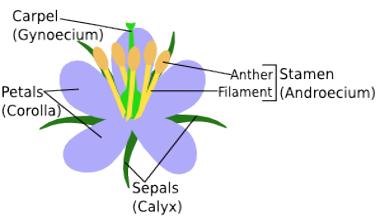The androecium is composed of stamens. It is the male reproductive part of the flower. Each stamen which represents the male reproductive organ consists of a stalk or a filament and an anther. Each anther is usually bilobed and each lobe has two chambers, the pollen-sacs. It contains anther and filament and produces pollen grains or male gametes. The pollen grains are produced in pollen-sacs. A sterile stamen is called staminode. Stamens of flower may be united with other members such as petals or among themselves.
The Parts of the Androecium – An androecium is usually made up of multiple stamina; each is composed of two parts, the filament, and the anther.
- Filament: the long, thin stalk of a stamen,
- Anther: the top of a stamen that produces pollen grains.
Flowers are made up of both reproductive and non-reproductive structures arranged in four whorls. These include the calyx, the corolla, the gynoecium, and the androecium. When stamens are attached to the petals, they are epipetalous as in brinjal or epiphyllous when attached to the perianth as in the flowers of lily.

- Calyx: outermost whorl made up of generally green, leaf-like structures called sepals,
- Corolla: whorl that contains often brightly colored petals,
- Androecium: third whorl that contains male reproductive structures called stamens,
- Gynoecium: innermost whorl made up of female reproductive structures called carpels.
The outermost whorl of the flower has green, leafy structures known as sepals. The sepals, collectively called the calyx, help to protect the unopened bud. The second whorl is comprised of petals, generally, brightly colored, collectively called the corolla.
The stamens in a flower may either remain free (polyandrous) or maybe united in varying degrees. The stamens may be united into one bunch or one bundle (monadelphous) as in china rose, or two bundles (diadelphous) as in pea or into more than two bundles (polyadelphous) as in citrus. There may be a variation in the length of filaments within a flower, as in Salvia and mustard.
Both the calyx and corolla are the non-reproductive structures of a flower, while the androecium and gynoecium are the reproductive structures. The gynoecium is the female reproductive part of the flower. The gynoecium produces egg cells, and the androecium produces sperm cells.














